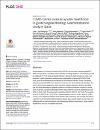COVID-19 risk score as a public health tool to guide targeted testing: A demonstration study in Qatar
| Author | J. Abu-Raddad, Laith |
| Author | Dargham, Soha |
| Author | Chemaitelly, Hiam |
| Author | Coyle, Peter |
| Author | Al Kanaani, Zaina |
| Author | Al Kuwari, Einas |
| Author | A. Butt, Adeel |
| Author | Jeremijenko, Andrew |
| Author | Hassan Kaleeckal, Anvar |
| Author | Nizar Latif, Ali |
| Author | Mohammad Shaik, Riyazuddin |
| Author | F. Abdul Rahim, Hanan |
| Author | K. Nasrallah, Gheyath |
| Author | M. Yassine, Hadi |
| Author | G. Al Kuwari, Mohamed |
| Author | Eid Al Romaihi, Hamad |
| Author | H. Al-Thani, Mohamed |
| Author | Al Khal, Abdullatif |
| Author | Bertollini, Roberto |
| Available date | 2022-08-31T20:27:50Z |
| Publication Date | 2022 |
| Publication Name | PLoS ONE |
| Identifier | http://dx.doi.org/10.1371/journal.pone.0271324 |
| Citation | Abu-Raddad, L. J., Dargham, S., Chemaitelly, H., Coyle, P., Al Kanaani, Z., Al Kuwari, E., ... & Bertollini, R. (2022). COVID-19 risk score as a public health tool to guide targeted testing: A demonstration study in Qatar. PloS one, 17(7), e0271324. |
| Abstract | We developed a Coronavirus Disease 2019 (COVID-19) risk score to guide targeted RTPCR testing in Qatar. The Qatar national COVID-19 testing database, encompassing a total of 2,688,232 RT-PCR tests conducted between February 5, 2020-January 27, 2021, was analyzed. Logistic regression analyses were implemented to derive the COVID-19 risk score, as a tool to identify those at highest risk of having the infection. Score cut-off was determined using the ROC curve based on maximum sum of sensitivity and specificity. The score's performance diagnostics were assessed. Logistic regression analysis identified age, sex, and nationality as significant predictors of infection and were included in the risk score. The ROC curve was generated and the area under the curve was estimated at 0.63 (95% CI: 0.63-0.63). The score had a sensitivity of 59.4% (95% CI: 59.1%-59.7%), specificity of 61.1% (95% CI: 61.1%-61.2%), a positive predictive value of 10.9% (95% CI: 10.8%- 10.9%), and a negative predictive value of 94.9% (94.9%-95.0%). The concept and utility of a COVID-19 risk score were demonstrated in Qatar. Such a public health tool can have considerable utility in optimizing testing and suppressing infection transmission, while maximizing efficiency and use of available resources. 2022 Abu-Raddad et al. This is an open access article distributed under the terms of the Creative Commons Attribution License, which permits unrestricted use, distribution, and reproduction in any medium, provided the original author and source are credited. |
| Language | en |
| Publisher | Public Library of Science |
| Subject | COVID-19 study in Qatar |
| Type | Article |
| Volume Number | 17 |
Files in this item
This item appears in the following Collection(s)
-
Biomedical Research Center Research [660 items ]
-
COVID-19 Research [741 items ]


